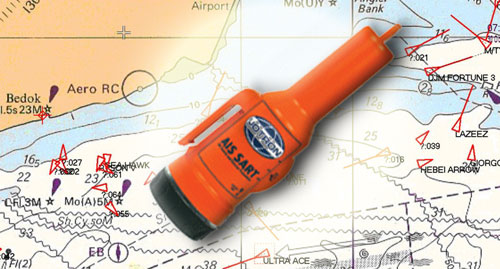Trump Tariffs on Russia’s Oil Buyers Bring Economic, Political Risks
From punishing Brazil to trying to curb imports of fentanyl, U.S. President Donald Trump has wielded the threat of tariffs as an all-purpose foreign policy weapon.

AIS has been a revolutionary product and, regardless of your opinion on its use, has changed the way mates handle heavy traffic situations. Jotron, makers of various SOLAS compliant marine safety electronics, is looking to bring this revolution to Search And Rescue operations with the introduction of an AIS enabled Search And Rescue Transponder (SART).
The device will work similar to traditional SARTs but, rather than show the position of a lifeboat on your 3cm radar, will transmit the exact GPS coordinates to all AIS enabled devices within VHF range.
We are excited not only by the product itself but the advancement of new ideas for sharing of data among the AIS network. gCaptain recently discussed the topic with the Coast Guard’s office for marine safety and is working with them to outline ideas to take AIS and data sharing from a point-to-point system to a web of collaborative sharing. Here is a basic summary of our question to marine safety:
AIS is a great system but it’s linear and data is stuck in predefined categories. Can a system be developed that facilitates discussion and information sharing between ship captain, pilots and VTS? We would be very interested in a system that facilitates discussion and allows collaboration between all parties.
One example of the failure of linear communication would be the Pasha Bulker incident. At first notice of the weather system that eventually caused the vessel to drag anchor and run aground, 56 ships were anchored in Newcastle Harbor. Each vessel received the same information via weather fax but 46 ships decided to head for the safety of sea, 10 stayed behind, 3 dragged anchor and one landed on the beach. Why had 10 captains interpreted the weather data so differently from the other 46?
Another example is the alission between the Cosco Busan and the San Francisco Bay Bridge. Why did her pilot decide to get underway while others delayed departure?
The answer to both questions lies in the minds of each Captain but our knowledge of vessel operations brings us to the conclusion that there is a sever lack of collaboration among Captains. This is particularly troubling in aggregate. Why? If we assume Captains have and average of 20 years on the job then the cumulative experience in Newcastle harbor that day exceeded 1120 years. In a time when the average employee can work from home with full access to company data, conference calls, shared documents and such why do we not share safety critical information between ships? The answer lies first in the attitude of self sufficiency that is present in the minds of most ship Captains but this is only half of the problem. The other half derives from the lack of systems capable of this type of collaboration. Could a system like AIS be transformed to allow the sharing of data, conditions and ideas?
I do not believe an AIS enabled SART will prevent the next big incident but the imaginative thought behind the idea combined with the use of existing infrastructure towards a specific goal (saving lives) is an encouraging notion indeed and gives us wide hope for the future.
For more creative uses of AIS technology be sure to read THIS POST over at Panbo. Also stay tuned for a look at AIS receivers aboard AeroMech AUV’s!

Sign up for gCaptain’s newsletter and never miss an update

Subscribe to gCaptain Daily and stay informed with the latest global maritime and offshore news
Essential news coupled with the finest maritime content sourced from across the globe.
Sign Up